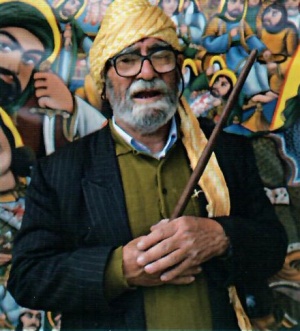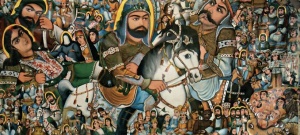Karim karimi mehr
Karim Karimi Mehr (born in1923) is a prominent Iranian Pardekhan whose reciting method is influenced by the melodies of southern Iran. He began Pardekhani when he was 14 years old under supervision of Ra’sil al-Foqara. His curtain was painted by Hossein Hamedani.
Karim karimi mehr | |
|---|---|
 | |
| Born | 1923 Pasargad |
| Nationality | Iranian |
| Known for | Pardekhani |
| Patron(s) | Ra'is ol-Foghara |
Performance Method[edit | edit source]
Darvish Karim motions can be divided into three groups:
1- Simultaneous indication to the faces while he is narrating about them.
2 -Indication to the audience (in greeting and respect, in asking for donation, advising and saying goodbye).
3 -Acting out religious ceremonies such as prayer, saluting the saints, championship motions such as shooting the arrow, holding up the shield ...
4 - Expressing emotions such as crying, grief, surprise, thought ...


Reciting Method[edit | edit source]
Darvish Karim use of a kind of vocal music which is influenced by the melodies of the south of Iran and is summed up in a few forms along with spoken prose but with typical harmonic sentences. Sequences of silences after expressing one of the sentences or a specific song is another feature of his music. The repeating forms with specific initial, middle and end and his narration are similar to that of Dhikr (God remembrance) or chant. The sound dynamic is related to the meanings of the story and the rhythm is quite consistent. His performance of Bahr-e Tawil is a mixture of the spoken word and the Nava mode space with emphasis on Bahr-e Tawil rhythm and the concepts of the story. At times the curtain-narrator instinctively sings without regard to the musical rules, he even in some sections maintains the intervals but changes the tonality and consequently one cannot find correspondence between the performance of Darvish Karimi Mehr and the structural space of Radif music .
Narration[edit | edit source]
In this gathering three stories are narrated, the Martyrdom of Abbas ibn Ali, the Christian Girl and Zamen-e Ahu (Deer-Keeper). In the story of the martyrdom of Abbas ibn Ali, Yazid's army is unable to win on the field of battle and resorts to unchivalrous ways and ambush him and cut off his hands. Abbas is extremely thirsty but upon arrival to the Euphrates river he does not drink because this is not a chivalrous way to be quenched while Imam Hussain's comrades including children are thirsty. In such condition Abbas takes the water skin in his teeth but the enemy army fills it with holes ... The Christian girl sees Ali Akbar, the son of Imam Hussain, in a dream and falls in love with him. The girl goes to Karbala where Ali Akbar is accompanying his father and other followers during the war with evil army. The Christian girl reaches Karbala when Ali Akbar has been martyred. The story of the Deer-Keeper tells of the saving of the female deer with several young by Imam Rida.
Source[edit | edit source]
- Ardalan, hamidreza (2008). Picture-storyteller masters of iran, the Iranian academy of the art, 2008, volume 2. ISBN: 978-964-2986-378(vol.2). 978-964-2986-002(set).

